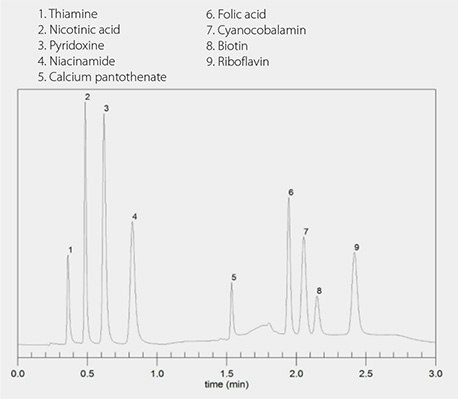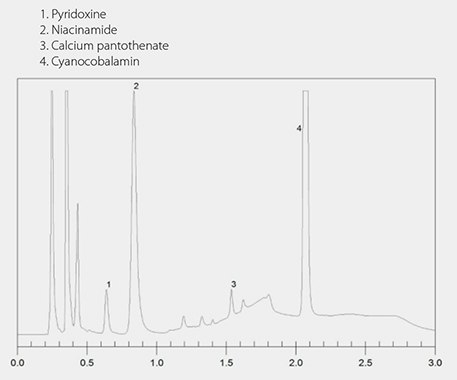HPLC Analysis of Water-Soluble Vitamins Using Titan C18 Column
Olga Shimelis
Reporter US
Volume 33.1
Introduction
Vitamins are important compounds and are essential for normal metabolism. They are naturally found in many foods and are often added to processed food products. Water soluble vitamins include such compounds as thiamine (B1), riboflavin (B2), niacin (B3), pyridoxine (B6), pantothenic acid (B5), biotin (B7), folic acid (B9), and cyanocobalamin (B12). Qualitative and quantitative analysis of vitamins is a routine but challenging task since vitamins are relatively unstable and affected by a number of factors such as heat, light, air, and other food components. In this report, a Titan™ C18 UHPLC column was used to analyze B vitamins in both standard mixture and in vitamin water.
Experimental
An Agilent 1290 UHPLC system was used for separations. The UV detection wavelength was set to 220 nm. The column used in this study was a Titan C18, 5 cm x 2.1 mm I.D., packed with monodisperse 1.9 µm particles. The column temperature was controlled at 35° C. The B vitamins are very hydrophilic, consequently a gradient with a low concentration of methanol and acidic mobile phase was used for elution under the reversed-phase conditions.
Water-soluble vitamins were obtained from us. Most B vitamins were dissolved in water. Riboflavin and biotin were dissolved in 1 M KOH and their solutions were prepared daily.
Orange flavored vitamin water was purchased in the grocery store. It was filtered through the 0.2 µm syringe filter for sample preparation.
Results and Discussion
B vitamins can be eluted from reversed-phase columns using low concentrations of aqueous acetonitrile or methanol. At pH 3, few compounds (thiamine, pyridoxine, niacineamide) were very weakly retained on the C18 Titan column and required only 0.5% of methanol for elution. Biotin, cyanocobalamine, and riboflavin vitamins are more hydrophobic and were retained more strongly. Gradient elution required an increase of methanol concentration to 30%. The Titan C18 column exhibited good retention for all nine vitamins and baseline separation for all vitamin peaks was easily achieved (Figure 1). All vitamins eluted within 2.5 minutes with good peak shapes. Although the Titan C18 column contained sub-2 micron particles, the total backpressure was not excessive when using the aqueous methanol mobile phase; which is known to be less compressible and results in backpressures higher than those using aqueous acetonitrile mobile phases. The Titan column backpressure peaked at 550 bar during the separation. The smaller particle size allowed for faster separation.
The developed HPLC method was applied to the analysis of B vitamins in vitamin water. The drink was filtered prior to injection to HPLC and no dilution was required. The peaks for four B vitamins were identified by comparison to the standard mixture (Figure 2).

Figure 1.Separation of Nine B-vitamins Using Titan C18 Column
Standard solutions were made at 100 µg/mL except 250 µg/mL for calcium pantothenate, riboflavin, and biotin.
CONDITIONS: column: Titan C18, 5 cm x 2.1mm, 1.9 µm (Product No. 577122-U); mobile phase: [A] 20 mM potassium phosphate, pH 3.0; [B] methanol; gradient: 0.5% B for 0.5 min, increase to 30% B in 1.3 min, hold at 30% B for 1 min, re-equilibrate at 0.5% B for 0.8 min; flow rate: 0.5 mL/min (backpressure not more than 550 bar); detector: UV, 220 nm; injection: 0.5 µL

Figure 2.Analysis of Vitamin Water Using Titan C18 Column
CONDITIONS: column: Titan C18, 5 cm x 2.1 mm, I.D., 1.9 µm (577122-U); mobile phase: [A] 20 mM potassium phosphate, pH 3.0; [B] methanol; gradient: 0.5% B for 0.5 min, increase to 30% B in 1.3 min, hold at 30% B for 1 min, re-equilibrate at 0.5% B for 0.8 min; flow rate: 0.5 mL/min (backpressure not more than 550 bar); detector: UV, 220 nm; injection: 0.5 µL
Conclusions
The use of a Titan C18 column for analysis resulted in excellent resolution of the mixture of nine water soluble vitamins in 2.5 minutes. The retention of polar compounds was adequate on the C18 column when using an aqueous methanol gradient and an acidic pH of the mobile phase. The method was applied to the analysis of the vitamin water and four B vitamins added to the water were identified.
To continue reading please sign in or create an account.
Don't Have An Account?